Defensive setups from corner kicks have evolved in recent football history.
The two main methods of defending corners have included zonal defending and man marking, with each type having its own securities and downfalls.
A mix of the two, a hybrid marking system, has started to become the trend when defending set plays, and we will look into why that is the case.
When teams concede and score goals from corners, it usually seems like the goal is down to luck.
However, we are here to describe why and how teams can strategise corner kick deliveries to expose weak spots of specific defensive systems and why the best set-piece teams don’t need luck to score from these chances consistently.
In this tactical analysis, we will look into the tactics behind different methods of defending corner kicks, with an in-depth analysis of how each technique can be attempted and the benefits/blind spots that come with them.
This set-piece analysis will examine why different teams utilise different methods of defending corner kicks while looking into the most secure teams in Europe and their steps to be so strong defensively.
Man Marking For Defending Corner Kicks
Although this method isn’t common amongst the European elite, Inter Milan are among the few teams utilising an exclusive man-to-man defensive approach to corners.
Each player is assigned to an attacker, whose sole job is to prevent that player from being able to attack the ball, at the minimum disrupting their path to the ball, increasing the likelihood of each attacker making a mistake should they make the first contact.
There is one zonal defender present, as Manchester City only have four players attacking this late corner, whose job is to prevent a low cross from going directly into the six-yard box.
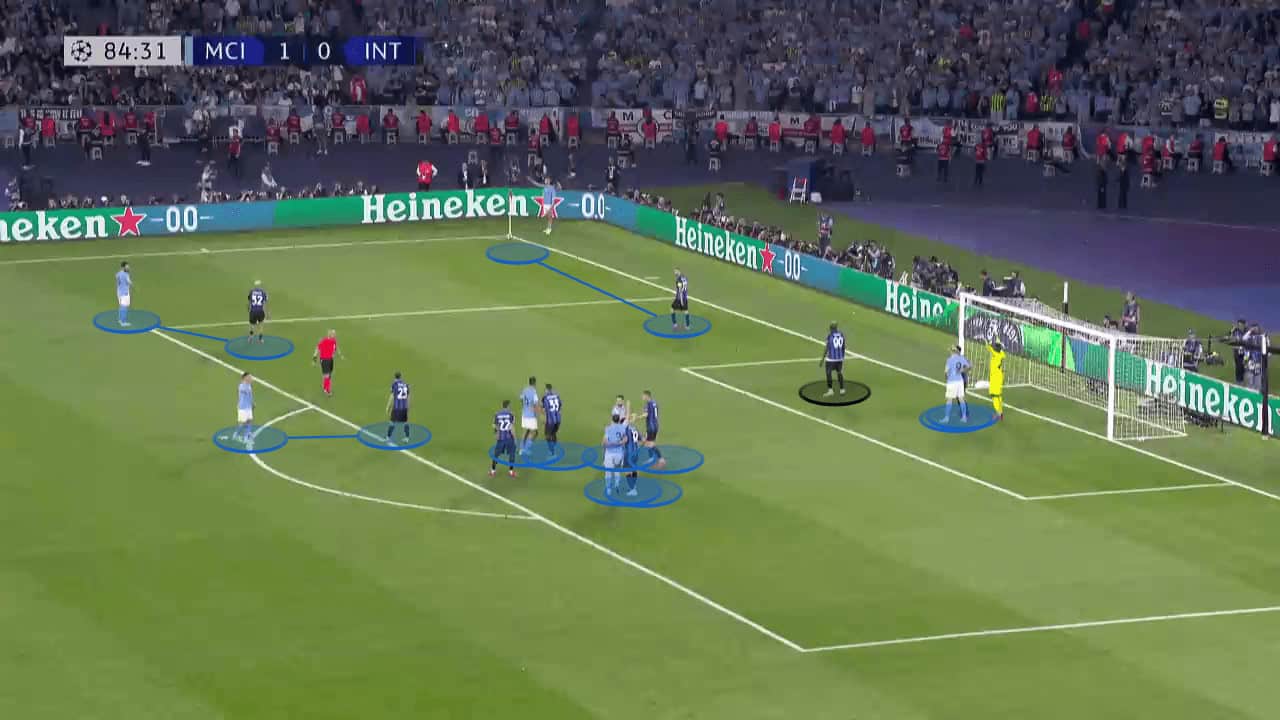
Man-marking approaches are most effective when the space to attack behind a defensive block is limited.
In situations with a lot of space available, attackers can easily lose their marker.
However, when the space is limited, and attackers begin in the space between the penalty spot and the six-yard box, the area becomes congested.
As a result, each attacker individually has less space to manoeuvre in.
Therefore it is tricky to lose their marker.
Furthermore, when the attackers begin so close to the six-yard box, it becomes impossible for them to gain an advantage in the aerial duel by taking a run-up towards the ball to gain momentum.
An attacker’s movement is minimal, so they cannot gain an edge in the vertical leap.
If the attackers get in behind a defender, they will enter the black zone pictured below, which is within the goalkeeper’s reach, and they can easily step out to claim the ball.
Because of the limited space surrounding the attackers, the only possibility is to create separation through quick feints.
Still, because of the safety behind each defender, they can mark attackers tightly.
Each Inter defender can get tight to their player, as seen in the image below, which makes it even harder for attackers to evade their markers.
This clearly shows how man-marking can be an effective tool for defending corners but should be used when attackers have limited options and there is no fear of space in behind being penetrated.
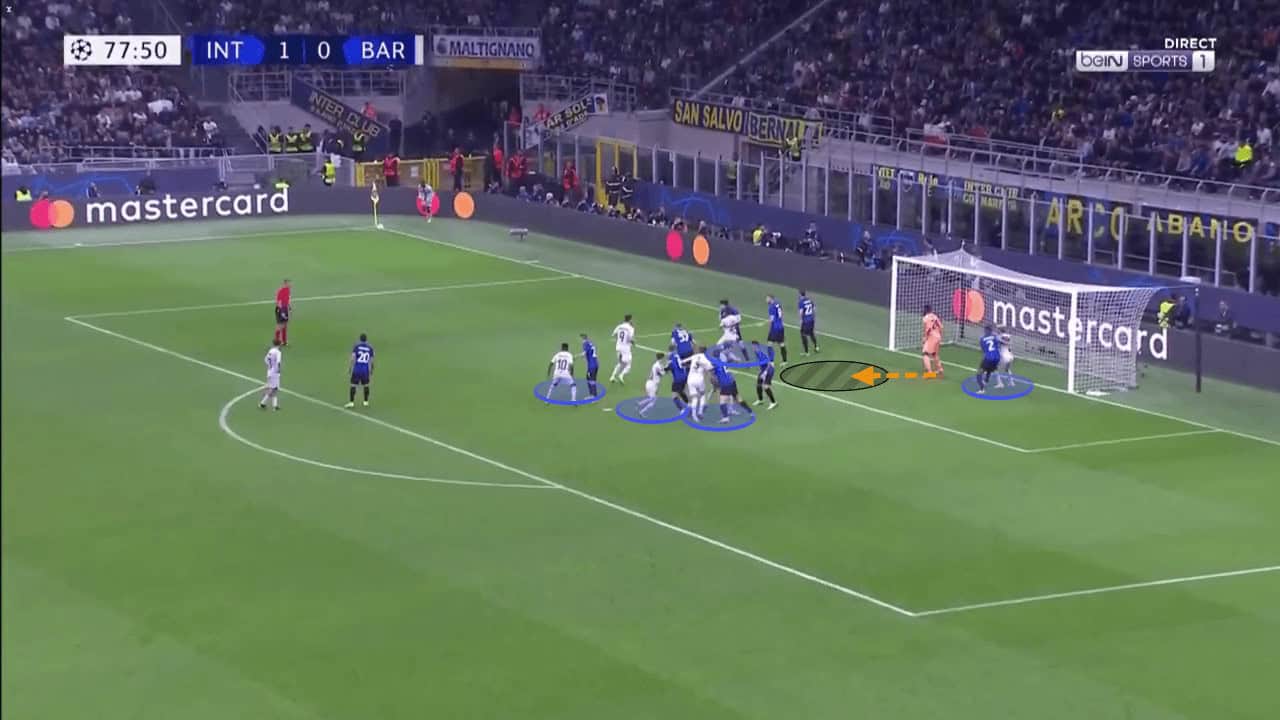
When there is space for attackers to run into, between the goalkeeper’s zone of control and the penalty spot, they are able to attack the ball with enough speed and from a close enough distance to cause problems for the defending team.
Marking tightly becomes more challenging due to the number of possibilities each attacker has.
When starting their run from deep, an attacker can attack either post, forcing the defender to keep their body open and facing away from the goal, in case of a change of direction.
This leaves them with their back facing the goal, allowing an attacker to quickly outpace their marker in a sprint towards the six-yard box, where they can attack the ball unopposed.
The number of options for an attacker leaves them with the advantage, which results in defenders having to drop off to give themselves the time they need to readjust their body and position, depending on the attacker’s choice.
Exclusive man-marking setups are susceptible to being outplayed through large-scale movements and individual actions.
Events such as screens can cause defenders to lose track of their attacker, leaving them with a free path to attack the goal.
Attacking teams can also create large-scale routines to make man-marking a confusing event during set plays.
Attackers can come into close contact and form a train, as pictured below.
With the attackers being so close to each other, defenders are unable to be tight to their attackers as there is no space, which further encourages each defender to drop their position deeper.
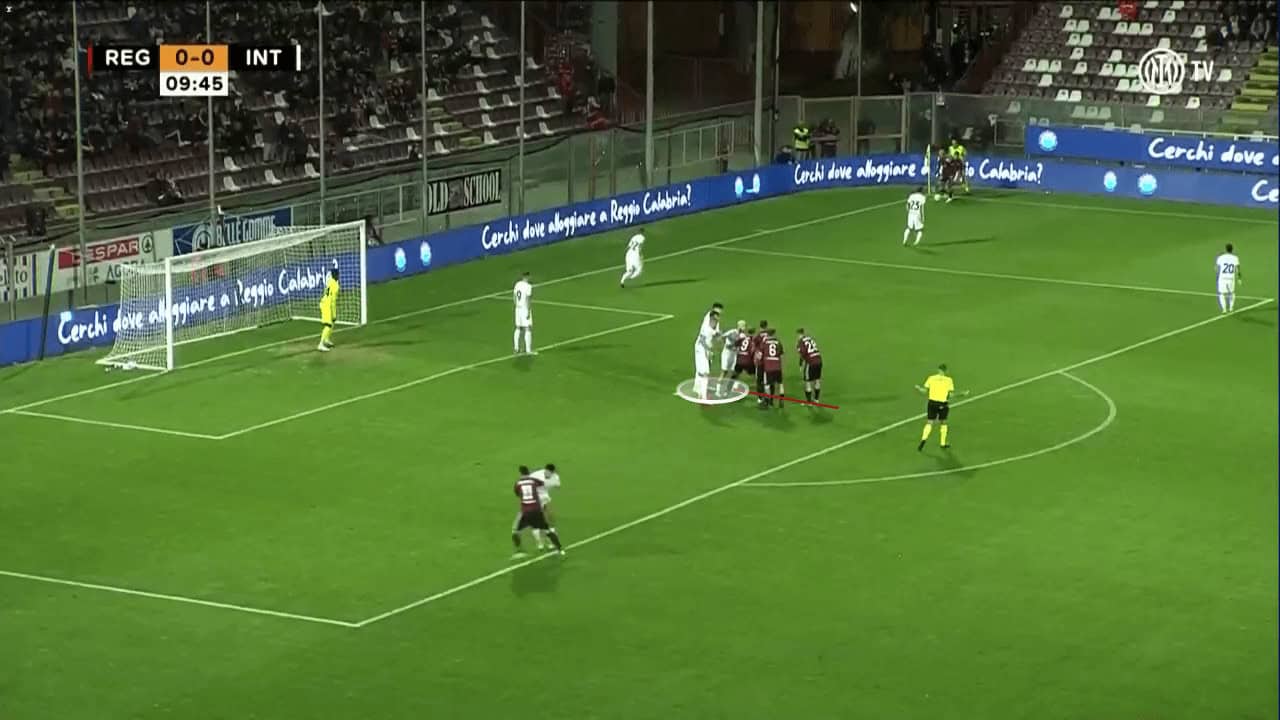
Once each attacker makes their run, defenders have little time to communicate, to pick up any free players, and the simultaneous movements become hard to track, as defenders start to track their nearest player, even if they aren’t assigned that individual.
This creates confusion where two players mark one attacker whilst another is left unmarked and free to attack the ball at his will.
Defenders have to track the ball while also trying to identify which attacker they are supposed to be marking, which leads to many mistakes in such a fast-paced situation.
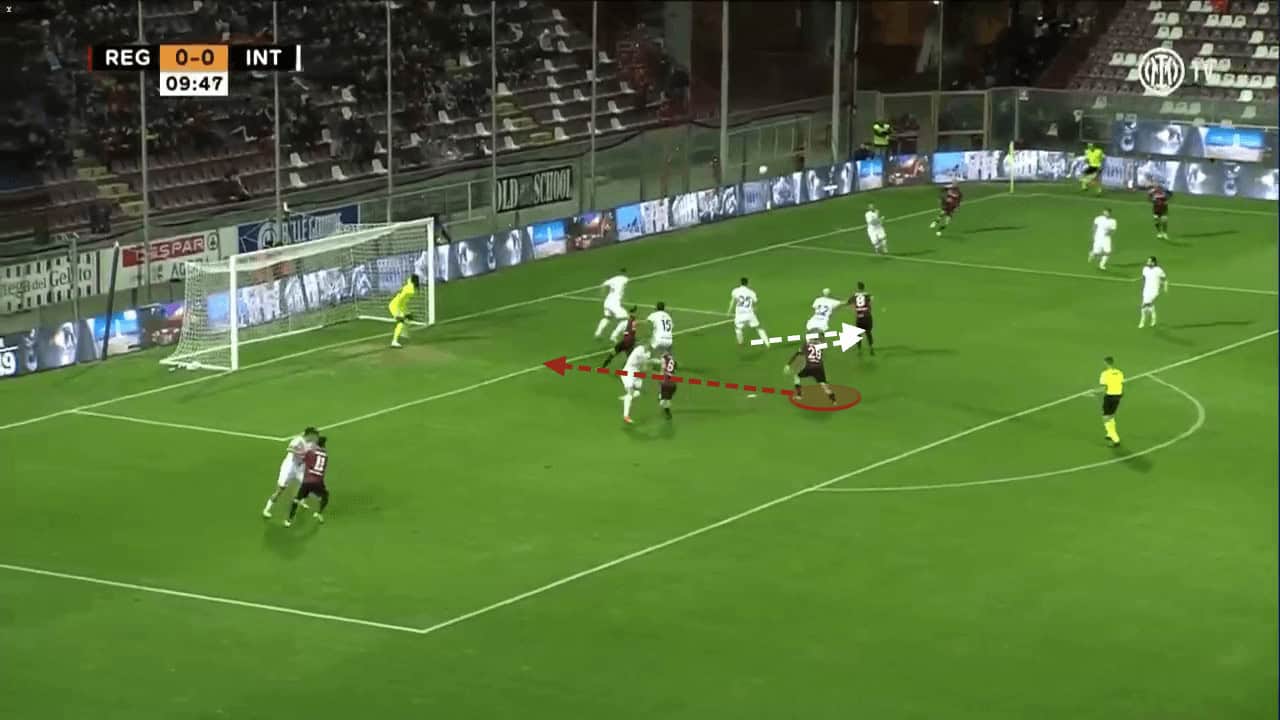
The biggest flaw with man-marking is that dangerous areas around the goal remain unmarked, which is especially deadly in the moments after the first contact.
When the ball is first played in, each attacker is closely marked.
However, once the ball is in flight, every defender has to adjust their position depending on the ball, which leads to players losing their marker.
Once the first flick is made from corners, man markers have a tough job: judging the trajectory of the ball while marking the attacker.
Attackers, meanwhile, have a more straightforward task of only worrying about where the ball will end up, so they can freely move to different areas inside the six-yard box while trying to lose their marker, like in the example below.
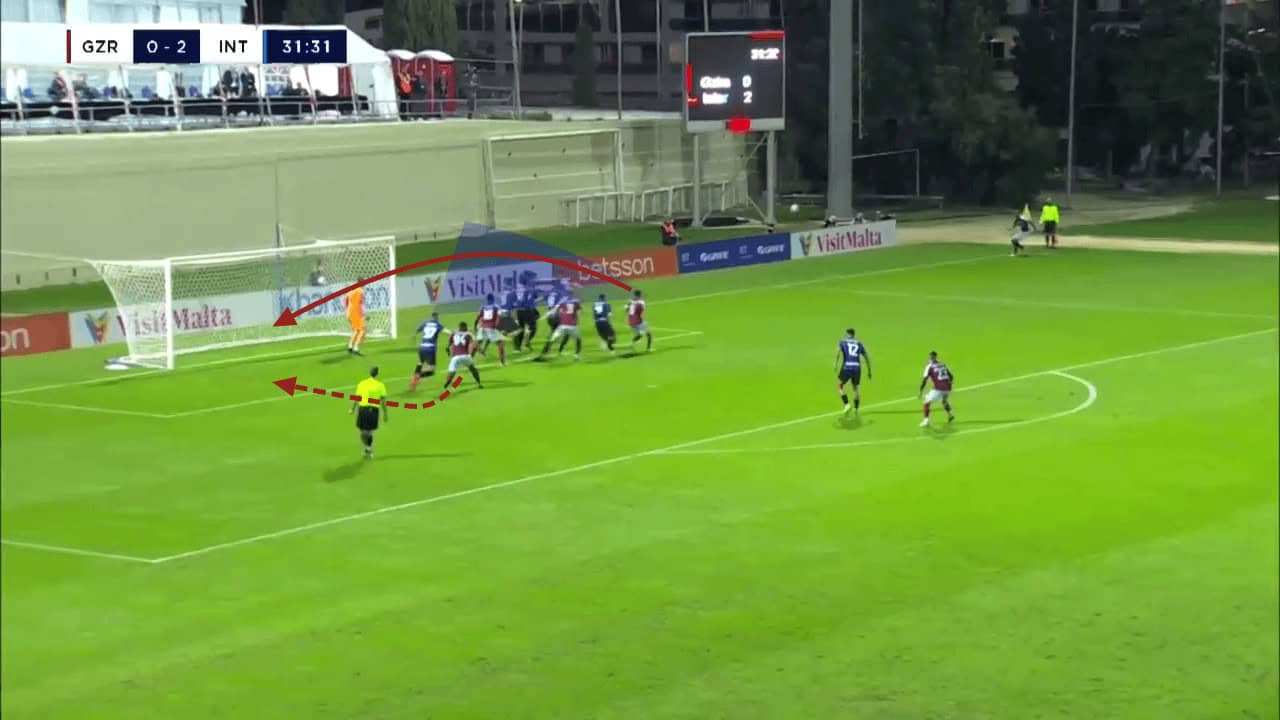
Zonal Marking For Defending Corner Kicks
The other standard method of defending is through defending space zonally.
With this method, defenders protect the most dangerous areas inside the 18-yard box and around the six-yard box whilst allowing players in deeper areas to freely attack the ball, with that added distance being far enough that even if contact is made, the shot wouldn’t be as threatening.
Below is an example of the type of setup which can be expected from zonal defending, with six different players protecting the six-yard box whilst the remaining players cover the edge of the area and pick up remaining attackers inside the box.
With this system, we can see that the entire six-yard box is in Tottenham‘s control, forcing opposing teams to cross the ball away from the six-yard box.
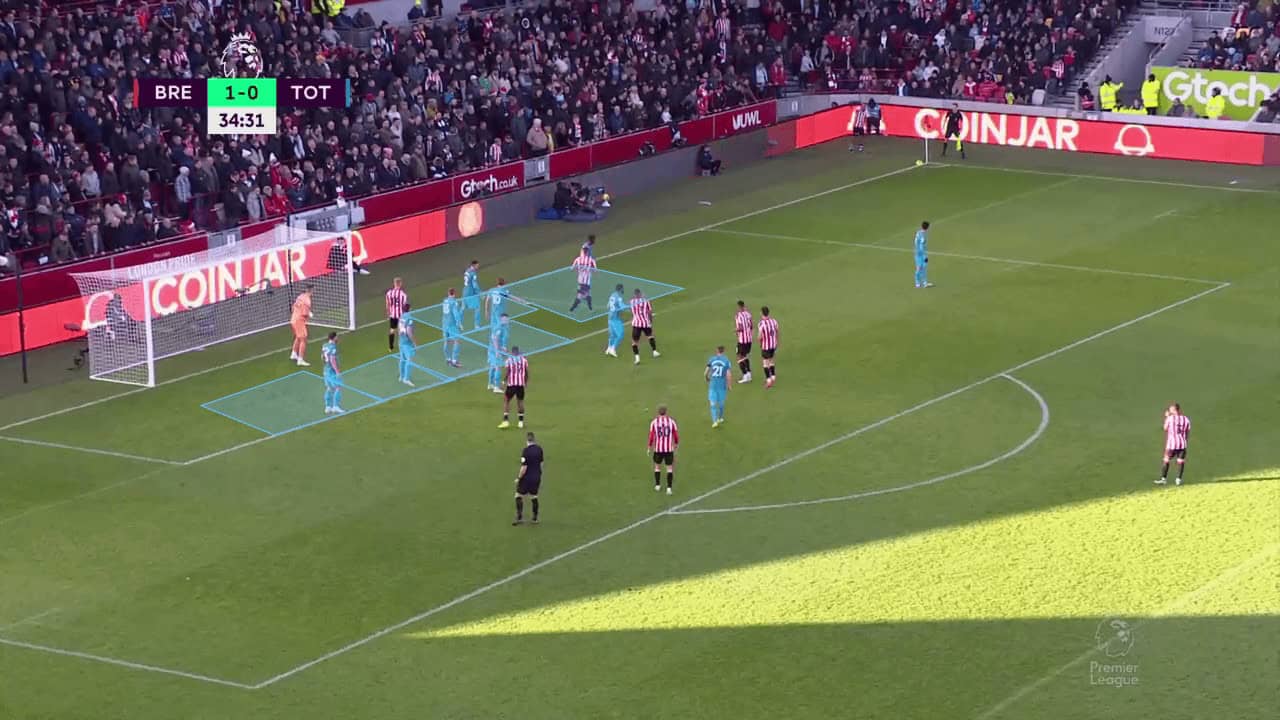
The problem lies in the fact that attacking players can group up and overload individual zonal defenders.
The example below illustrates how 3 Brentford attackers coordinate their attack at the near edge of the six-yard box, where there is only one zonal defender.
One attacker can sacrifice himself through a screen or a decoy run to disrupt the zonal defender, leaving the remaining Brentford player to attack the ball unopposed from six yards out.
With zonal defences being susceptible to overloads due to their lack of adaptability, zonal defenders are vulnerable to these sorts of overloads consistently, as well as being exposed to the possibility of being attacked by a runner from deep, who is at an advantage due to having a run-up towards the ball, in comparison to static zonal defenders.
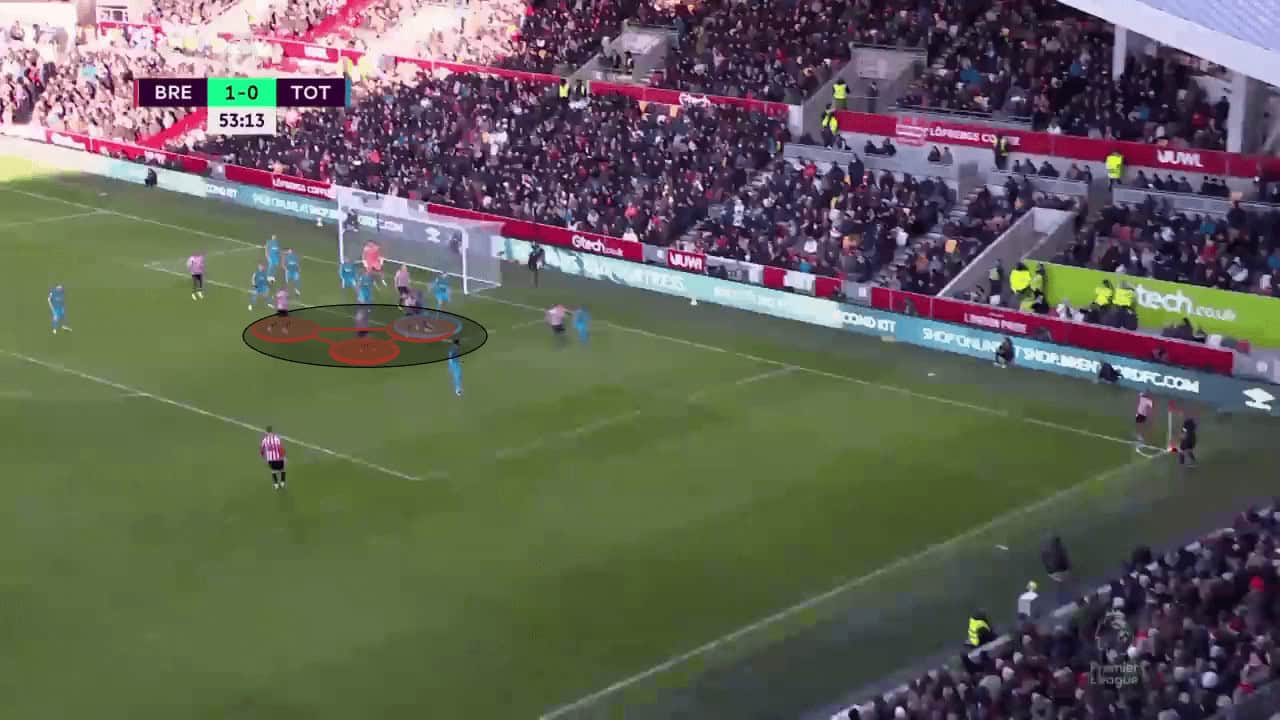
Hybrid Marking For Defending Corner Kicks
The most common method to defending corners at the moment is to utilise a hybrid method, consisting of a mix of man and zonal marking.
Below is an example of Fulham utilising this method, with six players marking zonally whilst the remaining players mark the free Bournemouth attackers.
This method combines the benefits of both other methods into an extremely strong style of defending corners.
The strongest defensive teams from corners have used this method, with teams such as Fulham and Brentford being extremely defensive in their methods, making sure all 11 players are behind the 18-yard line.
The zonal defenders are shown below, with the different amounts of space they each have the potential of controlling.
Players further away from the ball are able to defend bigger spaces due to the extra time they have to move in whilst the ball travels.
However, a player’s ability to defend space depends heavily on their individual qualities regarding how they are moving across space, as well as their reading of the game.
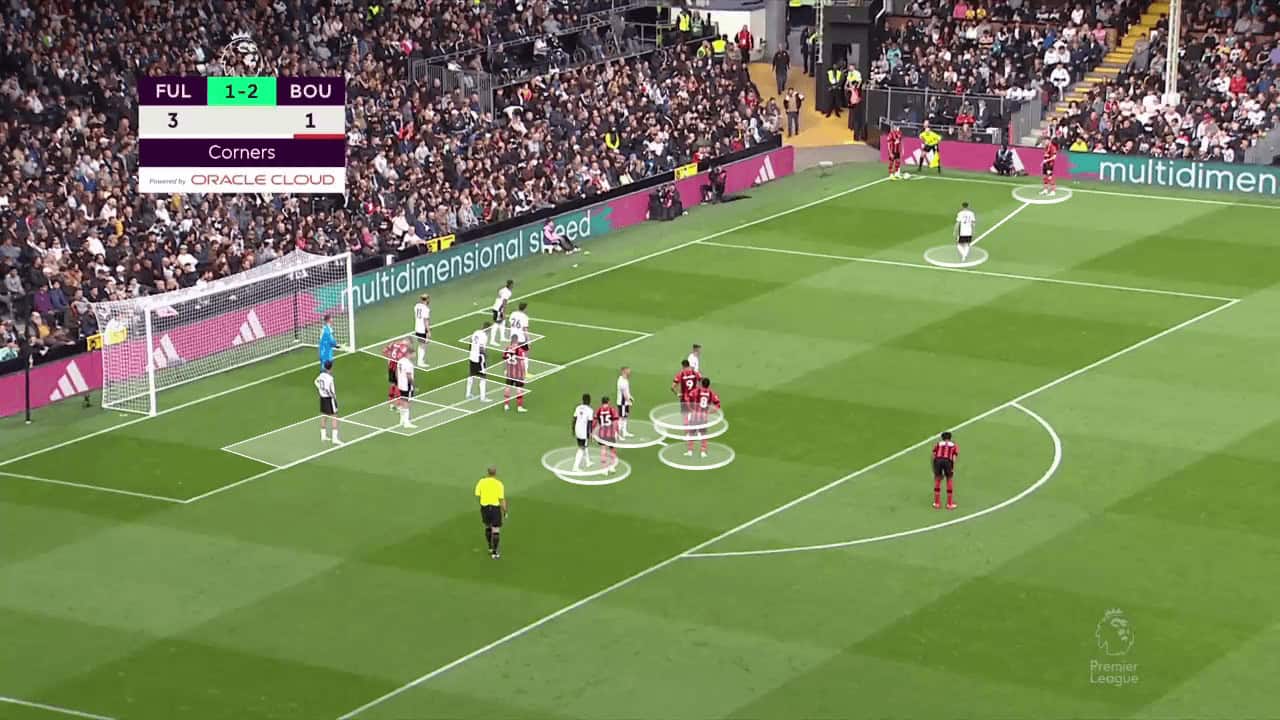
While the teams who defend with every available player are more secure from dead balls, it is essential to note that adequately defending every potential opening inside and around the box is impossible.
When defending corners, teams must be able to protect the six-yard box, which usually involves around five or six players.
They must also be ready to defend a short corner, a ball played into the edge of the box as well as picking up any remaining attackers lingering around the penalty spot.
Discounting the corner taker and goalkeeper, attacking teams can use nine players when attacking corners, whilst defending teams use 5/6 players to defend the six-yard box, leaving five players at most to defend the remaining nine attackers.
This shows it is impossible to defend every possible open space.
So defending teams must be humble in that they are always vulnerable, and any complacency or lack of pressure can leave them in danger.
From corners, one of:
- Short option
- Player on the edge of the box
- Attacker inside the box
- Space inside the six-yard box
will always be left unmarked, but only if a team commits everyone forward.
It is up to the defending team to determine which of these they are prepared to leave unmarked, depending on the opposition they face.
When defending teams throw every player into their own box, they are vulnerable to teams being able to sustain pressure against them as no one is left to defend the edge of the box.
This means they will still be under attack even if they clear the ball.
Teams can especially be left in vulnerable positions as they try and push the defensive line out of the box.
The line moving up requires coordination and timing from every defender, which can be hard when it involves attackers who are not used to stepping up as a unit.
In these scenarios, defending teams can be left exposed where one player hasn’t stepped up and, as a result, has left several players onside.
Furthermore, as the defensive line steps up and focuses on the ball, they can be unaware of runners on their blind side and potentially allow someone to attack the box from deep unmarked, which is the exact thing they tried to avoid in the first place.
In this instance, as the defensive line steps up, Sabitzer is able to attack the box unmarked and use the opposite momentum of the defensive line to gain plenty of time inside the box for himself.
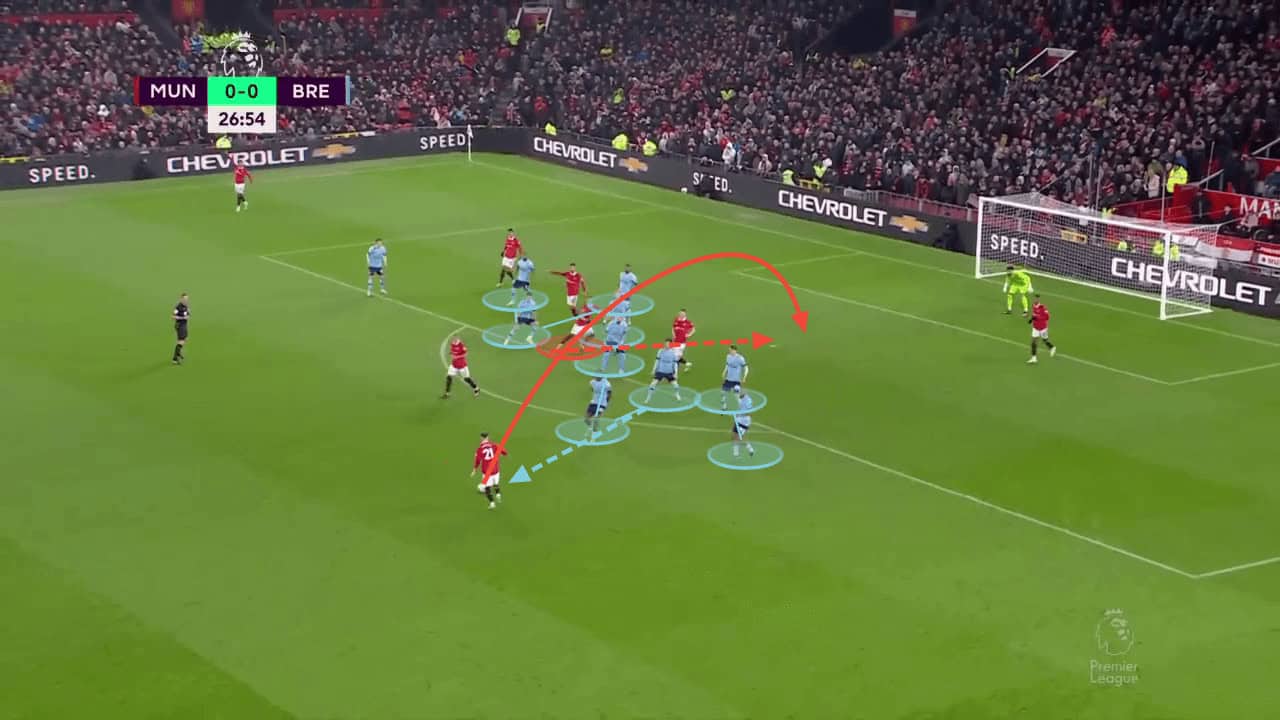
When teams fully focus on defending and deep inside their box, they are vulnerable to shots from range.
In this example below, Aston Villa work a short corner where Douglas Luiz is able to find himself with time by the byline.
With the Brentford players so deep, we can see the free space around the edge of the box, where the ball is played into.
Aston Villa are then able to score a goal with a free shot on goal from within 18 yards, almost like a free kick but with a moving ball.
Furthermore, with many defensive players inside the box, the crowd blocks the keeper’s view, making the shot easier for the forwards.
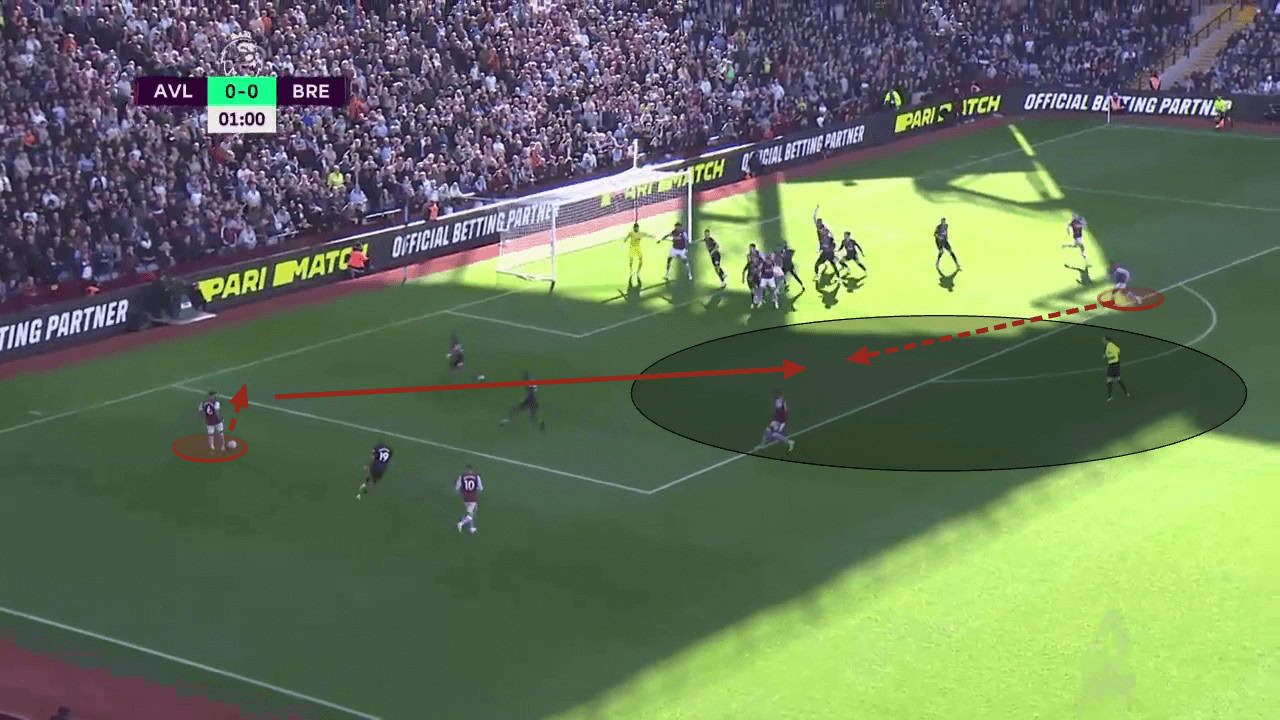
In the instances where teams protect their box and the option on the edge, a short passing options is usually left unmarked.
This will depend on the quality of the opposition, but when a team backs off and allows someone with the quality of Kieran Trippier to cross the ball in following a short corner, they will be punished.
Like with the defending team stepping out during the second phase of corners, timing is critical yet uncommon amongst defensive sides from corners.
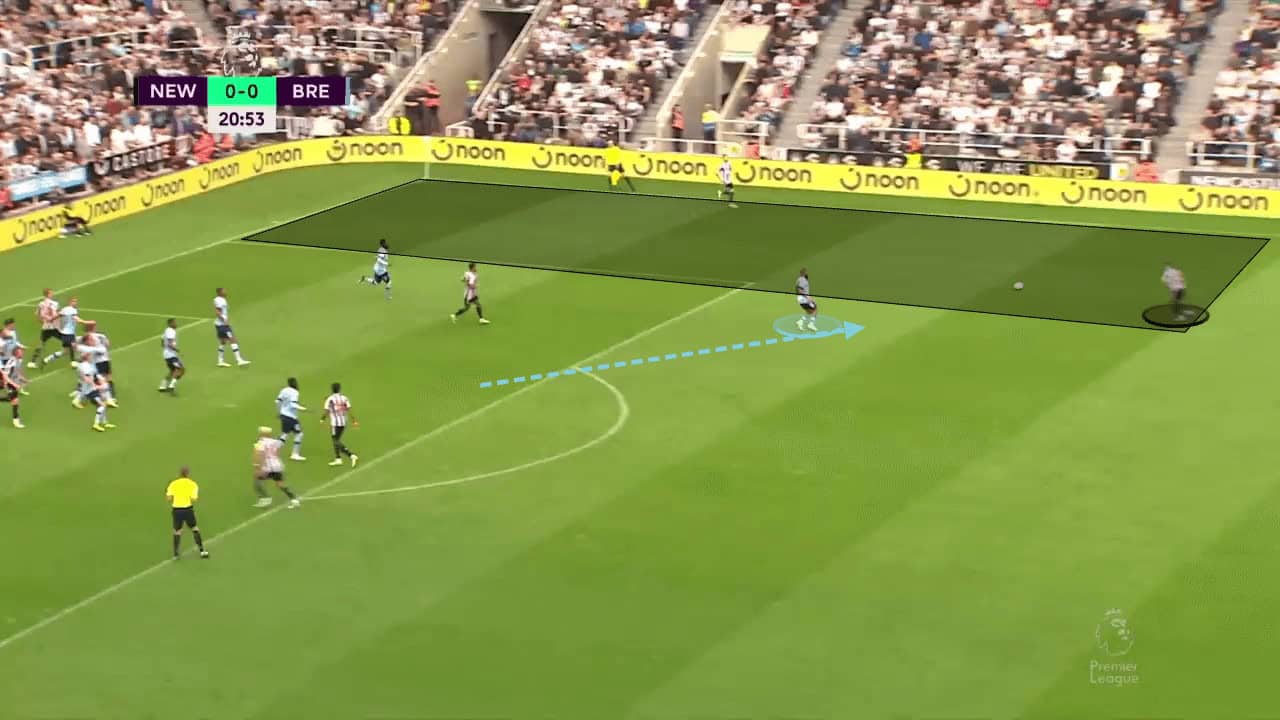
We can see in the image below most Brentford players have successfully stepped up, but there are still two defenders forcing the line to be deeper, making it even easier for attackers to time their runs into the box.
The cross from deep into the back post, against the momentum of a defensive line, is a highly effective routine against deep blocks.
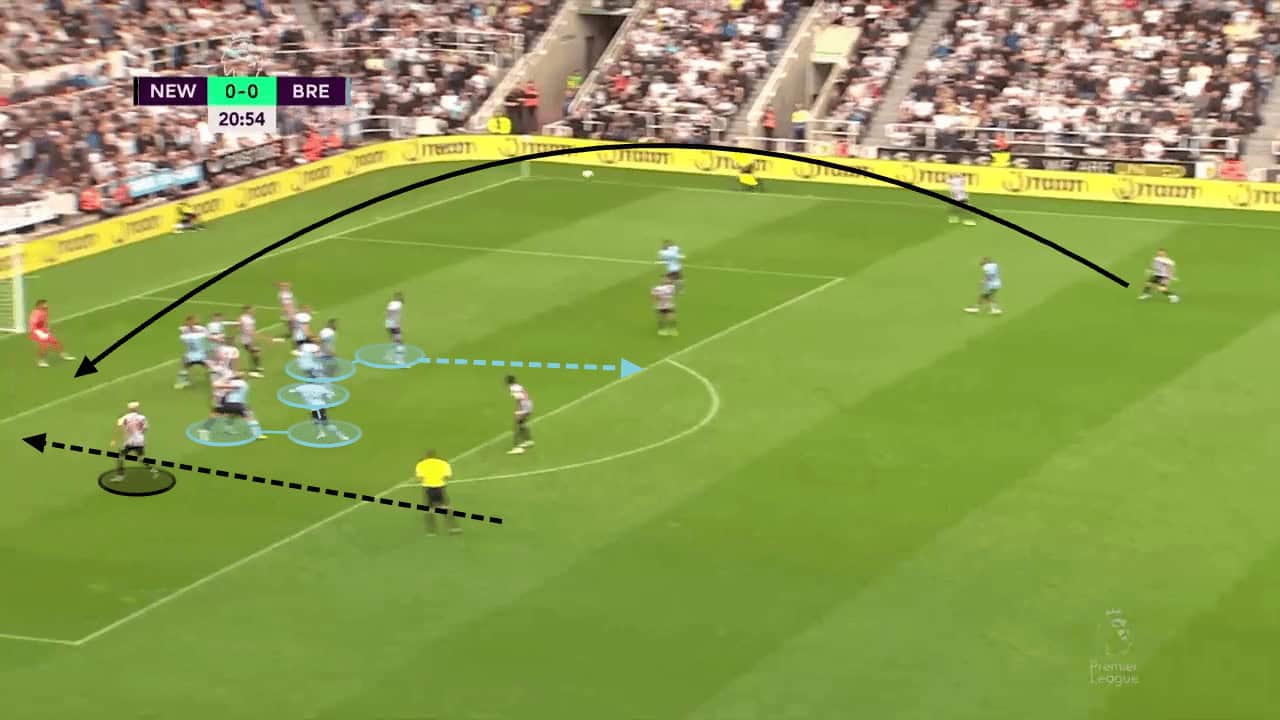
In the example below, we can see Southampton setting up with the hybrid method for a corner.
They have complete control of the six-yard box but are outnumbered inside the black area, just outside the six-yard box.
Whilst focusing on the player on the edge of the box, they have left an attacker unmarked inside the box.
All that is required for the attacking team, in this instance, is to immobilise every remaining player inside the black zone through various screens/ decoy runs to allow the free man to attack the ball unopposed.
Although the remaining Newcastle attackers could not create the space for the spare player in this instance, the chaos that ensued from the overload was enough to force Southampton into committing a mistake and conceding a goal.

Summary
This tactical analysis has detailed the ways in which man-marking and zonal defensive setups differ and work.
Each type has its benefits and risks, whilst the hybrid method of both has shown to be the most secure method of defending corners.
However, even with the most secure methods, risks come attached, and this analysis has detailed that corners are a part of the game, making defending teams extremely vulnerable.
No method of defending corners is entirely secure, so attacking teams will always have the upper hand in these dead-ball situations, with the attacking team holding all the cards from set plays.





Comments